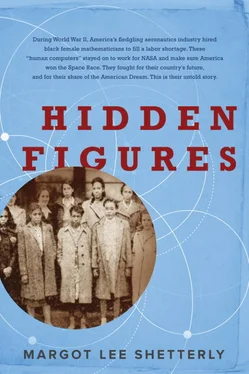But before a computer became an inanimate object, and before Mission Control landed in Houston; before Sputnik changed the course of history, and before the NACA became NASA; before the Supreme Court case Brown v. Board of Education of Topeka established that separate was in fact not equal, and before the poetry of Martin Luther King Jr.’s “I Have a Dream” speech rang out over the steps of the Lincoln Memorial, Langley’s West Computers were helping America dominate aeronautics, space research, and computer technology, carving out a place for themselves as female mathematicians who were also black, black mathematicians who were also female. For a group of bright and ambitious African American women, diligently prepared for a mathematical career and eager for a crack at the big leagues, Hampton, Virginia, must have felt like the center of the universe.
Melvin Butler, the personnel officer at the Langley Memorial Aeronautical Laboratory, had a problem, the scope and nature of which was made plain in a May 1943 telegram to the civil service’s chief of field operations. “This establishment has urgent need for approximately 100 Junior Physicists and Mathematicians, 100 Assistant Computers, 75 Minor Laboratory Apprentices, 125 Helper Trainees, 50 Stenographers and Typists,” exclaimed the missive. Every morning at 7:00 a.m., the bow-tied Butler and his staff sprang to life, dispatching the lab’s station wagon to the local rail depot, the bus station, and the ferry terminal to collect the men and women—so many women now, each day more women—who had made their way to the lonely finger of land on the Virginia coast. The shuttle conveyed the recruits to the door of the laboratory’s service building on the campus of Langley Field. Upstairs, Butler’s staff whisked them through the first-day stations: forms, photos, and the oath of office: I will support and defend the Constitution of the United States against all enemies, foreign and domestic… so help me God .
Thus installed, the newly minted civil servants fanned out to take their places in one of the research facility’s expanding inventory of buildings, each already as full as a pod ripe with peas. No sooner had Sherwood Butler, the laboratory’s head of procurement, set the final brick on a new building than his brother, Melvin, set about filling it with new employees. Closets and hallways, stockrooms and workshops stood in as makeshift offices. Someone came up with the bright idea of putting two desks head to head and jury-rigged the new piece of furniture with a jump seat in order to squeeze three workers into space designed for two. In the four years since Hitler’s troops overran Poland—since American interests and the European war converged in an all-consuming conflict—the laboratory’s complement of 500-odd employees at the close of the decade was on its way to 1,500. Yet the great groaning war machine swallowed them whole and remained hungry for more.
The offices of the Administration Building looked out upon the crescent-shaped airfield. Only the flow of civilian-clothed people heading to the laboratory, the oldest outpost of the National Advisory Committee for Aeronautics (NACA), distinguished the low brick buildings belonging to that agency from identical ones used by the US Army Air Corps. The two installations had grown up together, the air base devoted to the development of America’s military airpower capability, the laboratory a civilian agency charged with advancing the scientific understanding of aeronautics and disseminating its findings to the military and private industry. Since the beginning, the army had allowed the laboratory to operate on the campus of the airfield. The close relationship with the army flyers served as a constant reminder to the engineers that every experiment they conducted had real-world implications.
The double hangar—two 110-foot-long buildings standing side by side—had been covered in camouflage paint in 1942 to deceive enemy eyes in search of targets, its shady and cavernous interior sheltering the machines and their minders from the elements. Men in canvas jumpsuits, often in groups, moved in trucks and jeeps from plane to plane, stopping to hover at this one or that like pollinating insects, checking them, filling them with gas, replacing parts, examining them, becoming one with them and taking off for the heavens. The music of airplane engines and propellers cycling through the various movements of takeoff, flight, and landing played from before sunrise until dusk, each machine’s sounds as unique to its minders as a baby’s cry to its mother. Beneath the tenor notes of the engines played the bass roar of the laboratory’s wind tunnels, turning their on-demand hurricanes onto the planes—plane parts, model planes, full-sized planes.
Just two years prior, with the storm clouds gathering, President Roosevelt challenged the nation to ramp up its production of airplanes to fifty thousand per year. It seemed an impossible task for an industry that as recently as 1938 had only provided the Army Air Corps with ninety planes a month. Now, America’s aircraft industry was a production miracle, easily surpassing Roosevelt’s mark by more than half. It had become the largest industry in the world, the most productive, the most sophisticated, outproducing the Germans by more than three times and the Japanese by nearly five. The facts were clear to all belligerents: the final conquest would come from the sky.
For the flyboys of the air corps, airplanes were mechanisms for transporting troops and supplies to combat zones, armed wings for pursuing enemies, sky-high launching pads for ship-sinking bombs. They reviewed their vehicles in an exhaustive preflight checkout before climbing into the sky. Mechanics rolled up their sleeves and sharpened their eyes; a broken piston, an improperly locked shoulder harness, a faulty fuel tank light, any one of these could cost lives. But even before the plane responded to its pilot’s knowing caress, its nature, its very DNA—from the shape of its wings to the cowling of its engine—had been manipulated, refined, massaged, deconstructed, and recombined by the engineers next door.
Long before America’s aircraft manufacturers placed one of their newly conceived flying machines into production, they sent a working prototype to the Langley laboratory so that the design could be tested and improved. Nearly every high-performance aircraft model the United States produced made its way to the lab for drag cleanup: the engineers parked the planes in the wind tunnels, making note of air-disturbing surfaces, bloated fuselages, uneven wing geometries. As prudent and thorough as old family doctors, they examined every aspect of the air flowing over the plane, making careful note of the vital signs. NACA test pilots, sometimes with an engineer riding shotgun, took the plane for a flight. Did it roll unexpectedly? Did it stall? Was it hard to maneuver, resisting the pilot like a shopping cart with a bad wheel? The engineers subjected the airplanes to tests, capturing and analyzing the numbers, recommending improvements, some slight, others significant. Even small improvements in speed and efficiency multiplied over millions of pilot miles added up to a difference that could tip the long-term balance of the war in the Allies’ favor.
“Victory through airpower!” Henry Reid, engineer-in-charge of the Langley laboratory, crooned to his employees, the shibboleth a reminder of the importance of the airplane to the war’s outcome. “Victory through airpower!” the NACA-ites repeated to each other, minding each decimal point, poring over differential equations and pressure distribution charts until their eyes tired. In the battle of research, victory would be theirs.
Читать дальше
Конец ознакомительного отрывка
Купить книгу












